How to deal with orchid pests
Choosing an optimal location, creating ideal lighting conditions and sufficient humidity are the “three whales” that ensure the growth of indoor flowers. It is also necessary to protect green pets from pests, to protect against pathogens of infectious diseases.
In case of suspicion of infection, the indoor flower is isolated from others. First aid measure - washing the plant under running water. Insects fall, their number is reduced, the fight against the rest is facilitated.
Chemical treatment
Many indoor plant lovers are biased towards pesticides. Modern drugs based on pyrethroids, neonicotinoids, microbial strains are effective in small quantities, quickly decompose when released into the environment, and are relatively safe for it.
Chemicals (pesticides)
| Groups | Insecticides | Acaricides | Insecto-acaricides |
| What pests | Kill insects | Affects ticks | Get rid of insects and ticks |
| Preparations for the treatment of orchids | Inspector, Doctor, Spark Gold | Apollo, Sunmight, Vertimek, Aktofit | Aktara, Aktellik, Fitoverm |
Aktara is a drug for sucking pests, which include aphids. Contains neonicotinoid - a synthetic substance that is stronger than tobacco extract. Produced in the form of powder, granules, tablets, soluble in water.
Prepare a solution, spray orchids in the absence of children and pets in the room (or take out plants for processing on a balcony, loggia). Aktara protects the plant for a month or longer.
Fitoverm is a biopesticide of intestinal action, belongs to the 3rd hazard class. After spraying, insects die within 2-4 days.
Actellic is an organophosphate substance that belongs to hazard class 2. The pesticide acts quickly and effectively on pests, but it is not recommended for use in residential premises.
Spark Gold - a preparation based on a synthetic analogue of natural insecticides found in Dalmatian chamomile (pyrethrum). These substances are less hazardous to humans than organophosphorus and organochlorine pesticides. Spark is released in the form of a powder for preparing a suspension, sticks placed in the soil.
Natural remedies
Orchids are sprayed with freshly prepared decoctions or infusions of tansy, Dalmatian chamomile, tobacco, wormwood, yarrow, onion husks. Herbs are cheaper than chemicals, safer for people, pets, and the entire environment. However, folk remedies are less effective than chemicals, the action ends faster.
What other pests can be found in orchids?
- The root mite is a tiny insect that damages weakened plant species by invading their tissue. In an infected plant, the roots and base of the shoots rot. Very rare.
- Greenhouse flat beetle mite - most often leaves are infect, acquiring a silvery-white color. Flowers and young leaves are deformed. With a strong defeat by this pest, the orchid dries up.
- Woodlice are small, crustaceans that live in the soil, leaving it at night. Small holes on young leaves, buds, flowers, damages growth points, as well as young roots.
- Crickets are a rare pest in the home collection. They are similar to grasshoppers. Size from 1 to 4 cm from gray to black. On young leaves, buds and flowers, there are large irregular holes. It also eats up young roots.
- Podura - tiny insects jumping on the surface of the substrate, 1-2 mm in size, which are indicators of the bay of the orchid. They appear in an acidic substrate, do not bring any harm. According to some reports, they are credited with damaging young roots.
- Tiny flies that feed mainly on the decay products of the substrate. But their larvae can also damage healthy parts of the plant, in particular the roots.
- Caterpillars and worm-like insect larvae that are easy to spot. Eaten up along the edge of the sheet. In tuberidia, passages have been consumed.
- Centipedes (kivsaki) are long, worm-like insects with a huge number of legs. They live in the soil, coming to the surface only at night. Small holes on young leaves, buds, flowers, damages growth points, as well as young roots.

Caring for flowers after their treatment
After all the pests of phalaenopsis have been eliminated, the flower must be properly looked after:
-
Lighting. It is necessary to place the orchid in a place with good lighting, but without direct sunlight. Due to the lack of light, the leaves stretch out, and flowering becomes rare.
Reference! Daylight hours should be 12 hours. - Temperature. For phalaenopsis, it is necessary to maintain a temperature of 18-27 degrees during the day, and 13-24 degrees at night.
- Watering. Phalaenopsis requires moderate watering to keep the ground moist, but not too wet. Water should be thawed, boiled and 2-3 degrees above room temperature. In the summer, moisten the soil 2-3 times a week, and in the winter - 1-2 times every 7 days.
- Fertilizers. Top dressing is carried out 1 time in 3 weeks. For this you need to use formulations intended for orchids. Overfeeding the flower is not worth it, since an excess of mineral salts negatively affects growth and flowering.
One of the rules for caring for phalaenopsis remains pest prevention. But due to bad weather conditions or violation of agricultural technology, the invasion of parasites cannot be avoided. To prevent the orchid from wilting and disappearing, it is necessary to start pest control and plant treatment as soon as possible, using the safest means possible.
The main indicator of the health of phalaenopsis is the condition of the root system. Read our resources on how to care for and grow orchid roots after improper care, how to recognize flower diseases by spots on the leaves and why roots and other parts of the plant dry out.
How to detect?
Insects feed on plant sap, they pierce the leaf and suck out nutrients from it. The surface of the sheet plate at the puncture site becomes silvery-green, later darkens, acquiring a dark brown or black color.
Another symptom is black dots on the surface of the leaf - the waste products of the pest. Also, on crops affected by thrips, peduncles, buds and new growths are bent. In some cases, you can see traces of pollen on fresh flowers - a sure sign of an insect. Most often, thrips can be found on Cattleya, Cymbidium and Phalaenopsis.
How to deal with them?
To get rid of spider mites and other types of mites at home, a number of effective measures should be taken. First of all, you need to disinfect the affected area. Diluted laundry soap should be used: one large spoonful of liquid soap is stirred in one liter of water. Using a cloth or sponge, gently wipe the surface of the plant.
After that, the substrate should be poured, the plant should be covered with a transparent film, and kept in this form for at least 70 hours. The film increases the percentage of moisture, which promotes active annihilation of insects and can heal the plant
It is important to remember that the orchid is afraid of direct sunlight, the flower should be kept in the shade.
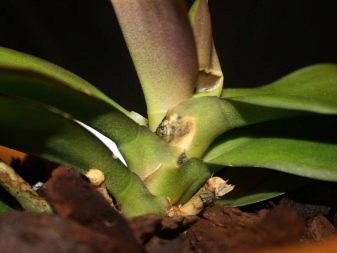
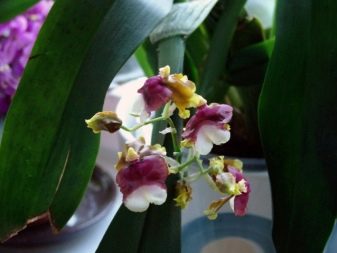
Chemicals
The most effective drugs in the fight against ticks can be acaricides:
- Aktofit;
- Fitoverm;
- "Vertimek".
Often, special chemicals are used against spider mites:
- Actellik;
- thiophos.
It is recommended to treat the plant with "chemistry" and at the same time create comfortable greenhouse conditions for it, covering it with a transparent film. Processing should be done with one of the preparations, and only then use the film
It is also important to remember that ticks are resistant parasites and can quickly produce antivenom. From time to time you will have to alternate chemical compositions
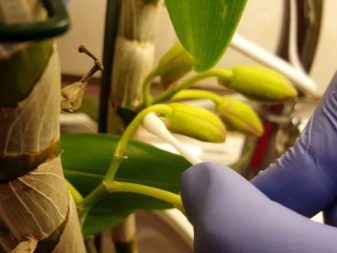

The root mite is considered the most dangerous. If there are signs of infection, then urgently:
- all affected areas are cut off;
- the places of the cuts are processed with potassium permanganate with the addition of activated carbon;
- diseased flowers are taken to another room;
- the soil from the pots is disposed of;
- the pots are wiped with a disinfectant.
The most effective formulations are:
- Fitoverm;
- Actellik;
- Apollo.
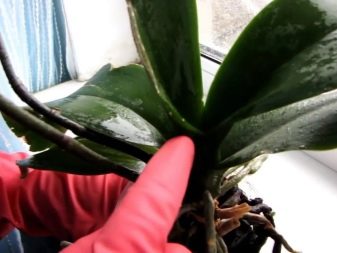
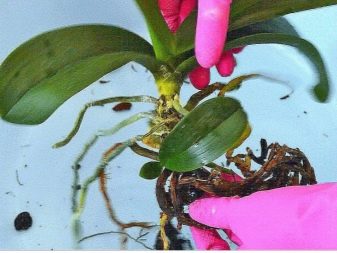
These substances are best alternated with such drugs:
- "Omite";
- "Kleschevit";
- "Vertimek";
- Dursban;
- Borneo;
- Sunmight;
- Oberon.
Each drug has its own advantages and disadvantages, much depends on the severity of the damage to the plant. If the process is at the very beginning, then such a chemical composition as "Apollo" will be enough. It helps to remove small colonies of ticks that have just begun to form.
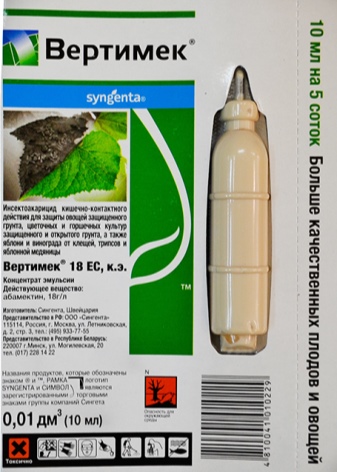
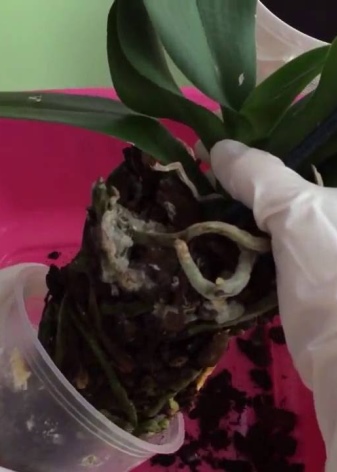
Folk methods
Traditional methods are effective only in the initial stages of plant disease. Laundry soap solution is the most common way to treat affected areas of orchids.
A decoction of cyclamen also works well, which is able to eliminate colonies of parasites without leaving a residue. To prepare a similar composition, you should:
- take the tuber of the plant, chop it finely;
- put the pieces in boiling water and boil for 30 minutes;
- cover the broth with a lid and leave for 24 hours.
Plants can be treated with this broth for a week.
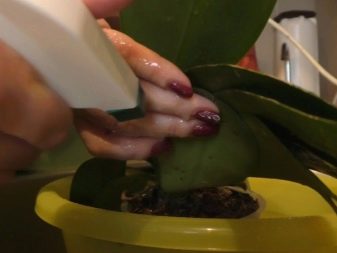
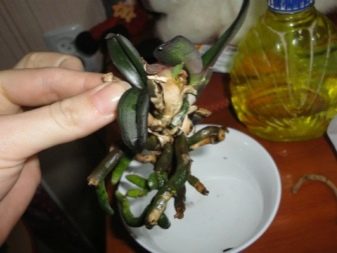
A decoction of nettle will help to activate the immunity of plants. It is done like this:
- 750 grams of fresh nettle is poured with three liters of boiling water;
- the resulting mixture is infused for 40 minutes.
When the broth has cooled, the orchid is immersed in it for 5-6 minutes.
The shell mite is considered no less harmful, it is extremely voracious and in a few days can gnaw a plant so that it will inevitably die. In this case, the orchid is removed from the soil along with the root system, soaked in water for 20 minutes. The plant is then removed and placed on a cotton rag, the roots must dry. It is recommended to do a similar procedure at least three times, after which the plant is installed in the renewed soil.
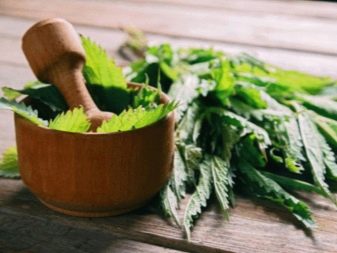
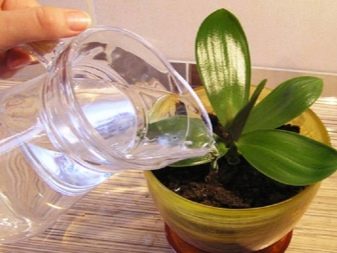
Orchid thrips
Orchid for thrips is no exception among other indoor plants, they can also settle on it. There are several types of pests by name thrips, you will get acquainted with them below. Miniature parasites are very dangerous for flowers of tropical origin and not only, since they feed on the sap of the plants they live on. As a result, it withers: the leaves dry up and the flowers wither, and the roots fall into decay. How can you avoid these terrible pests in your life and the life of your plant? What methods of fighting really help get rid of the “enemy”? If these pests appeared on your plant, and previously they were not, then where did they come from? You can find answers to these questions in this article.
Thrips should not be confused with other insects. Beetles live inside the stem, leaves and flowers of the plant, they are very small and not so easy to notice. Thrips have a body not exceeding 1 mm long, are very flexible and dodgy, mobile insects, move quickly and hide very skillfully.
Thrips could come to you with wildflowers, garden flowers or with the purchase of a new plant. The insect is difficult to see, it can only be seen with a magnifying glass. Thrips are also often called fringed and vesiculate insects.
Getting on a plant, this insect feeds on its juices, which makes it sluggish and the flowering period is shortened. There are a huge number of varieties of this parasite, but not all of them harm orchids. Specific species are dangerous for orchids, namely:
- tobacco thrips,
- Californian,
- American,
- dracaena.
You can find an insect by the black dots on the plant, these are the waste products of the parasite. Due to the fact that thrips feed on the vital sap of the plant, the flower's immunity weakens, and it becomes readily available for fungal diseases.
It is very important to detect this parasite in the early stages of flower disease. This can be done by carefully examining the orchid with a magnifying glass.
Larvae are more difficult to find than an adult. The larva is whitish-transparent in color, and the adult is dark in color. Take a close look at your plant using a magnifying glass. Do not forget to also inspect the roots of the flower, leaves on both sides and axils, as well as points of development, plant growth, petals, buds, peduncles and buds. It's great if you have experience with thrips so you can spot them effortlessly.
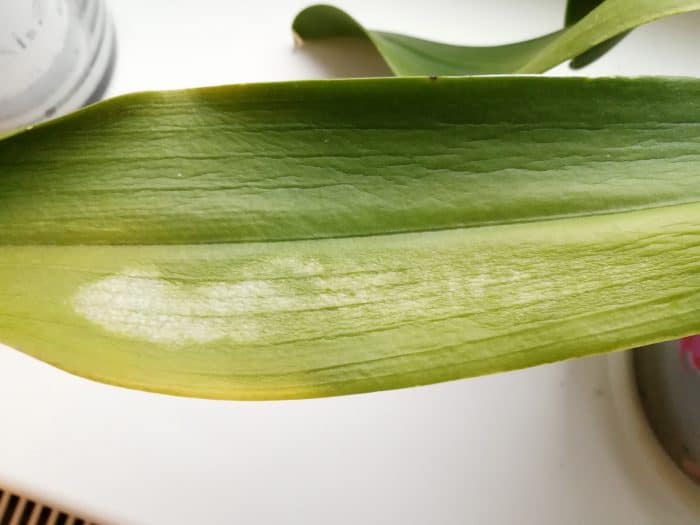
You can recognize the pest by the black small dots on the leaves of plants. Let it not scare you, it's all just insect feces that helped to detect it. If there are brown or dark spots on the leaves of an orchid, dry, without pus, know that the female thrips laid the larvae. By opening the stain, you can find the offspring of the pest.
There is another popular method for detecting the parasite - shaking the flower stalk of the plant. Holding the flower above the water, you need to shake the peduncle by tapping on it. If the thrips is there, it will fall into the water.
Types of orchid pests
A newly purchased or donated plant should be carefully examined for signs of pests.
Thrips
Give out their appearance with small black dots on the leaves and uneven lesions in the form of small strokes. Both adults and larvae are dangerous. Buds and flowers are also damaged.
Mealybug
The mealybug marks its presence by the appearance of plaque on the roots of the plant, the substrate, the walls of the pot. A grayish fluff, reminiscent of cotton wool, forms around the female pests. Adult parasites and larvae live in flowers, buds, and leaf axils, sucking out sap.
Spider mite
It is quite difficult to see a spider mite, but its presence is betrayed by a spider web that has appeared on the tops of young shoots. The mite sucks the juices out of the plant, greatly weakening it.
Aphid
Pests accumulate on young shoots and leaves, bite through the surface layer of the epidermis. The sticky juice forms an ideal environment for fungus to grow.
Shield
It lives on the back of the leaf, on the stems of the shoots. Sticky spots, dark bumps and growths are the first signs of infection. Then the leaves turn yellow and fly around.
Nematode
They are dangerous in that they can damage all parts of the plant: roots, stems, leaves, buds. The infected plant lags behind in development, the leaves are deformed, light grooves and spots appear on them. Nematodes cause root necrosis, pseudobulb death.
Means to fight
Chemical
You can get rid of pests that have affected phalaenopsis if you use the following drugs:
- Aktara. This drug has a systemic effect on pests such as scale insects, chervens, aphids and thrips. At the same time, the tool is absolutely safe for others. When used, the plant receives protection for up to 2 weeks.
- Aktara. You can use the product for spraying or watering. Treatments should be carried out at intervals of 7-10 days.
- Actellic. This drug is effective against aphids, whiteflies, ticks, fleas, scale insects and thrips. Sometimes even one treatment is enough.
- Agrevertin. This remedy acts against the same pests as the previous drug, but only of a weaker action.To prepare the solution, take 1 liter of water and 5 ml of the product.
- Bi 58. This is a strong universal preparation. One-time treatment is carried out with a solution obtained from 30 ml of the product and 1 liter of water.
Folk
You can get rid of pests using proven home remedies:
- Phalaenopsis leaves can be treated with a cotton swab dipped in vegetable oil. Under the oil film, chervens and scale insects will begin to suffocate. Treat in the morning or evening.
- For oil spraying, you need to take 1 liter of water and 40 ml of olive oil. Apply the resulting emulsion to the affected area. Do the procedure 1 time a week 3 times.
Reference! In hard-to-reach areas, you can use a brush to apply oil. - Chop a clove of garlic, and treat the affected areas with the resulting juice. Carry out processing once a week 3-4 times.
Biological
The following biological preparations are effective for the treatment of phalaenopsis:
- Bicol. It is an acaricidal preparation that is derived from the bacterial strain Bacillus thuringiesisvar thuringiesis. Used to eliminate spider mites. Bicol quickly eliminates pests, as it has an intestinal effect.
- Verticillin. It is an insecticide derived from the fungus Verticillium lecanii. The drug is used in the fight against whitefly. Its action is that the conidia or blastospores of the fungus seep through the insect's integument and invade its body. There they grow and infect his organs.
Methods for the prevention and control of thrips
Almost all varieties of thrips do not tolerate high environmental humidity and a lot of light, and they prefer moderate rather than high temperatures, so the pest is usually activated during the heating season or during long-term stable rainless weather. It is during these months of the year that one should especially carefully examine the seamy side of the leaf plates, where thrips populations primarily settle.
For prevention, experienced orchievods advise placing sticky tapes next to flowers, but many have noticed that thrips for some reason do not like yellow, but prefer blue and would rather drown in a blue saucer of water than stick to yellow Velcro.
Priority actions when thrips are detected:
Insect-infested orchids are isolated from other specimens of the home collection in a separate room.
Putting the affected plant under a warm shower and washing off the insects will help reduce their number on the flower, but not get rid of the pests completely; in addition, your orchid must be moved carefully so as not to shake off insects near other plants - thrips will not slow down to move to a new victim.
Depending on the degree of damage, insects are destroyed with folk or chemical means.
Folk recipes for fighting thrips:
- A soap solution prepared at the rate of 15 g per liter of water has proven itself well as a universal means of combating various insect-parasites of orchids and other indoor plants;
- often helps to get rid of thrips with a regular spray to give shine to the leaves;
- garlic infusion - 4-5 peeled cloves of garlic are squeezed out and poured in 0.5 liters of boiling water, infused for 4 hours and spread with a brush on the affected areas of the orchid;
- a solution of olive oil for spraying - 1-2 tablespoons are diluted in 1 liter of water.
Chemicals used to kill thrips:
- celaflor;
- pyrethrum powder;
- Buyer Lisetan Plus and Buyer Lisetane Combigranulate;
- vertimek;
- unpleasant;
- Nurell D and others.

Many chemicals are oil-based. These funds resist pests well, but have a significant drawback - they clog the pores of the leaf plates, impede the penetration of air, and contribute to the destruction of the leaf in the bright sun. Thin-leaved orchids, including phalaenopsis, are especially affected.
The treated plants are transferred to partial shade for 2 weeks, in addition, when working with such sprays, it is necessary to read in the instructions at what distance the agent should be sprayed from the flower, since hypothermia of the leaf plates is possible.
To combat thrips, granular preparations are used, which are placed in a substrate, and as they dissolve, they are absorbed by the root system.
However, many of them also contain fertilizers, so it is important to correctly determine the dosage so that the roots of the orchid do not suffer from excessive amounts of salts. It must also be remembered that a single treatment is almost always not enough, and it is advisable to repeat the procedure after 5-7 days.
It should also be remembered that a one-time treatment is almost always not enough, and it is advisable to repeat the procedure after 5-7 days.
What thrips look like - description with photo
What do thrips look like? You can study the description below, and in addition, see photos of these insects. They were first discovered and described by Karl de Geer in 1744, the original name for thrips was the phisapus (Physapus). In 1758, the naturalist Karl Lynn gave them their modern, familiar name, Thrips. Thrips are one of the most ancient insects, it is believed that they are the ancestors of all bugs. A description of the structure of the calf will help to distinguish this pest from others. The length of an adult reaches 1.4 mm, there are individuals with a curved tail, their length reaches 2 mm. Insects are mobile due to thin legs, which have suction devices at the ends and a tooth, wings of a yellow-brown color with distinct villi. In the mouth apparatus there are three prickly bristles, thanks to which thrips feed on the plant.
There are a huge number of varieties of thrips. There are four types of thrips that are dangerous to orchids, described below. Wings are not developed in everyone, but only in bread. Bread thrips can move in clouds from field to field. Fortunately, these thrips are not dangerous to the orchid.
- The most dangerous species is the Californian (western), common in the western regions of Europe. The parasite is almost omnivorous and destroys ornamental and flower plants, vegetable plantings, fruit-bearing trees. The insect carries a huge number of threats to a healthy plant.
- Tobacco - also known as onion thrips, adults. A miniature, inconspicuous insect that does great harm to orchids. The body length of the insect is up to 1.3 mm, the color of chitin is from light brown to black.
- American - found relatively recently - in the 90s on young shoots of miltonia and a recently obtained hybrid of spatoglottis, is dangerous for orchids.
- Dracene is a parasite with a black and white body up to 1.3 mm long. The color of the larvae is transparent white. Frequent inhabitant of orchid leaf plates.
In order not to infect your pet orchid, it is enough to follow some rules, which you will learn about later.
How to control or combat thrips on plants?
Controlling the number of thrips on plants is a very difficult process. Since we have determined that we will not kill all living insects on flowering plants, we must use control strategies that include the least toxic insecticides. Using the advice of experienced gardeners, ensure consistent watering and removal of dead or diseased plants from the site.
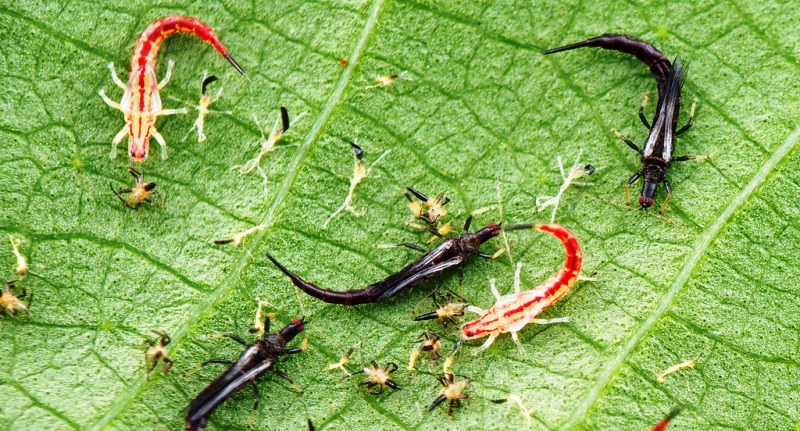 When dealing with thrips, you can trim and remove any damaged plant parts. Regular pruning helps to get rid of thrips. Flower thrips can be repaired as soon as you see signs of damage by using a mild insecticide such as insecticidal soap or neem oil, or by pruning the flowers. When taking effective and safe measures, be sure to make sure that you are not killing the beneficial thrips.
When dealing with thrips, you can trim and remove any damaged plant parts. Regular pruning helps to get rid of thrips. Flower thrips can be repaired as soon as you see signs of damage by using a mild insecticide such as insecticidal soap or neem oil, or by pruning the flowers. When taking effective and safe measures, be sure to make sure that you are not killing the beneficial thrips.
Where did I get the Thrips?
Thrips feed on vegetation and are often found inside plants, so you can bring thrips home with an infected plant or cut flowers. Pests look for water and can also move indoors through damp laundry. Thrips are tiny and difficult to spot.
Are Thrips safe for humans and at home?
These pests sometimes bite people looking for moisture on their skin. Thrips bites cause only mild irritation and usually have no long-term effects. Inside houses, pests feed on indoor plants, which often leads to the death or slowdown of their growth.
Common harmful insects with photos
Mites
These pests can infect the plant both in the store and at home. Ticks pierce the leaves of the phalaenopsis, as a result of which they begin to hurt, dry out and fall off (we talked more about the diseases and pests of phalaenopsis here). The buds cannot open, but instead slowly die. The parasite can be recognized by the presence of a cobweb on the leaf plate. You can get rid of ticks by picking them up with your hands and placing them in water. You can also spray the plant with Fitoverm once every 2 weeks.
Thrips
These little pests live almost everywhere in gardens. They are black and have 2 pairs of wings, so they don't have a problem to move from one plant to another. They hide in the ground, making them much more difficult to spot. After the bugs, silver traces remain on the foliage. Thrips suck sap from phalaenopsis, and they lay larvae in the roots. To overcome the pest, you need to spray the flower with a complex solution of Aktellik and Fitoverm.
Whitefly
This butterfly is small in size and milky in color. It feeds on plant sap and reproduces directly on the stems. After the defeat by the white-bore, the phalaenopsis becomes lethargic and weak, its leaves turn yellow and fall off. Since whiteflies fly perfectly, they can lay the larvae right under the leaves. You can eliminate the parasite using a solution obtained from 1 liter of water and 20 g of crushed laundry soap. Spray phalaenopsis with the prepared product once a week.
Sucking parasites
This group includes pests that feed on plant sap. Most often these are springtails. You can notice them by their brown color. They do not crawl or fly, but jump, so it is very difficult to catch the parasite. If there is a massive pest infestation, then they feed on the roots of the orchid. You can get rid of springtails if you reduce watering (2 times a week), and also treat the flower with Fitoferm.
Aphid
This parasite does not pose a danger to the flower, but its secretions, which it leaves on the leaves, prevent them from receiving oxygen. It is on such leaves that bacteria and fungi begin to multiply. To get rid of aphids, you need to use a solution with laundry soap, but do not spray the orchid with it, but wipe the affected leaf plates.
Nematodes
These are worms that are round in shape. They seep into the roots, stem and leaves. Pests feed on all the useful substances of phalaenopsis and suck out the juice. Nematodes not only feed on the plant, but also leave their secretions on it. Because of this orchid stop growing, and after a while dies. Nematodes do not like hot water, so you can warm up the flower. Just do it carefully so as not to destroy it.
Woodlice
These parasites are frequent guests of the orchid. You need to deal with them immediately, immediately after detection. And although wood lice move slowly, they are quite active in the ground. They hide during watering, making it difficult to spot pests. To combat pests, you need to lower the orchid in water and wait a little. After 2-3 minutes, woodlice will begin to crawl out. If the parasites remain, then it is better to transplant the flower, just rinse the roots thoroughly before that.
Mealybug
This parasite outwardly resembles a fluffy lump with a small mustache.For phalaenopsis, this cute insect is a serious danger, since it is not always possible to detect it in time. The mealybug chooses hard-to-reach places - roots. It sucks the juice from the plant, and leaves behind a white discharge.
Most often, this parasite is detected after the leaves begin to turn yellow and fall off. To defeat the pest, it is necessary to remove all dry and damaged leaves. You also need to carefully examine the places where the parasite may be. You can get it with a regular stick.
Shield and false shield
These insects suck out all the nutrients from the phalaenopsis, and after them a sticky liquid remains on the leaves and stems (what if the phalaenopsis has sticky leaves?). It is an excellent environment for the development of fungus and rot (for details on how to find out that the roots and other parts of the phalaenopsis orchid are rotting and what to do to save the flower, read here). Adult scale insects can lay larvae directly on the stem. They are attached to the plant, feeding on its juices. After a few days, the individual will mature and will cause significant damage to the plant.
Defeating such parasites is quite simple: you need to rinse the flower with water, after which the insects will leave. You can also treat the orchid with Aktellik and Fitoverma. Carry out this procedure 2 times a month. After getting rid of the parasites completely, phalaenopsis needs to be transplanted.
Pest control methods
In addition to replacing the substrate and pot, orchids are treated with treatment with special or home remedies.
Preparations and remedies
Florists in difficult advanced cases use insecticides:
- Actellik (contact action);
- Thiophos (neurotropic poison);
- Fitoverm (biological product);
- Neoron (contact acaricide).
The treated plant is covered with polyethylene to prolong the duration of the preparation and create a humid atmosphere.
Folk methods
Simple tools, affordable and inexpensive:
- infusion of garlic or onion;
- soft toothbrush to remove scabbards;
- oil emulsion (2 tablespoons olive oil per 1 liter of water);
- rubbing alcohol (for dense leaves).
Folk methods will only help in the initial stage of infection.


